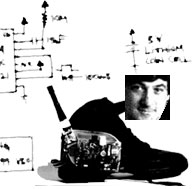Dedication
Introduction
Dan Ariely
Walter Bender
Steve Benton
Bruce Blumberg
V. Michael Bove, Jr.
Cynthia Breazeal
Ike Chuang
Chris Csikszentmihályi
Glorianna Davenport
Judith Donath
Neil Gershenfeld
Hiroshi Ishii
Joe Jacobson
Andy Lippman
Tod Machover
John Maeda
Scott Manalis
Marvin Minsky
William J. Mitchell
Seymour Papert
Joe Paradiso
Sandy Pentland
Rosalind Picard
Mitchel Resnick
Deb Roy
Chris Schmandt
Ted Selker
Barry Vercoe
Joe Paradiso
I like to explore. I live to take the less-worn, riskier path and discover the vista overlooking the next valley. This impulse has manifested itself across my life in many ways, ranging from my years in high-energy physics research peering into the microstructure of the universe, to my hobby of seeking highly obscure music that few have ever heard.
I am also obsessed with building. My need to make things is never satisfied—it's led me from building one of the world's largest modular music synthesizers to writing detailed simulations for the Space Shuttle's re-entry. Last but not least, the call of artistic expression, answered by endless hours spent in darkrooms and electronic music studios, is truly the siren that led me to the MIT Media Lab.
In forming the Responsive Environments group, I've been able to combine these motivations by innovating technology at the boundary where the outside world meets human and machine perception. This has precipitated the development of sensor technologies and sensor applications that open new channels of interaction for human-computer interfaces, human expression, and responsive spaces. A wonderful feature of the Media Lab is the possibility of connecting deeply with both creative and technical content; I've enjoyed being able to present the technology in appropriate academic and scientific forums while showcasing the results worldwide in performances and exhibitions. Since our projects often cut across the Media Lab and its sponsor community, I'm frequently stimulated by working with the Lab's extended network in channeling our inventions into diverse applications. When I designed a chair that tracked the gestures of a seated musician for interactive performance, I had no idea that it would lead to intelligent car seats that save lives in automobiles. In developing a shoe-based interface that gave a musician or dancer access to entirely new avenues of expression and control, we invented sensor architectures for a wearable mobile biomotion laboratory that will shortly be undergoing clinical tests. In designing a new form of musical instrument that allows sound to be freely sculpted and articulated by an ensemble of tagged objects, we invented a tracking system that can dynamically aim a radiation beam at a tagged tumor.
 Sensor development is a common thread that has linked much of my work. Although advances in microelectronics, fabrication technologies, and materials are revolutionizing the ways in which stimuli of nearly every modality can be electronically transduced or perceived, I'm most fascinated by the boundary where fine-grained sensing meets highly distributed, decentralized computing. Our ability to intimately blend diverse sensors with local, interconnected processing promises to usher in a new concept of intelligent materials or multimodal electronic skins, at the cutting edge where electronics fabrication, sensor integration, data fusion, ad-hoc networking, and emergent computation merge to launch a new field of sensing mechanisms with nearly biological complexity. Such work holds the potential for revolutionary applications in areas such as prosthetics, medical diagnostics, robotics, smart materials, and wearable computing.
Sensor development is a common thread that has linked much of my work. Although advances in microelectronics, fabrication technologies, and materials are revolutionizing the ways in which stimuli of nearly every modality can be electronically transduced or perceived, I'm most fascinated by the boundary where fine-grained sensing meets highly distributed, decentralized computing. Our ability to intimately blend diverse sensors with local, interconnected processing promises to usher in a new concept of intelligent materials or multimodal electronic skins, at the cutting edge where electronics fabrication, sensor integration, data fusion, ad-hoc networking, and emergent computation merge to launch a new field of sensing mechanisms with nearly biological complexity. Such work holds the potential for revolutionary applications in areas such as prosthetics, medical diagnostics, robotics, smart materials, and wearable computing.
Favorite piece of music recently released: I.E.M.'s "IEM Have Come For Your Children"